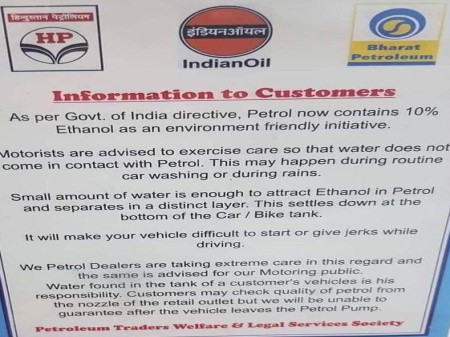Vehicle owners asked to exercise caution after govt introduces ethanol mixed petrol
By Lokmat English Desk | Published: August 26, 2021 09:01 PM2021-08-26T21:01:35+5:302021-08-26T21:01:58+5:30
Does your two-wheeler or four wheeler break down frequently, especially after servicing? Speculations are rife that, improper blending of ...

Vehicle owners asked to exercise caution after govt introduces ethanol mixed petrol
Does your two-wheeler or four wheeler break down frequently, especially after servicing? Speculations are rife that, improper blending of ethanol with petrol by oil marketing companies (OMCs) is causing problems for vehicle users. It is said that ethanol absorbs moisture from the atmosphere and when it comes into contact with the water in petrol tanks, it forms a distinct layer and settles at the bottom. This leads to the vehicles stalling or facing difficulty while starting.
Uday Lodh, president of the Federation of All Maharashtra Petrol Dealer’s Association (FAMPEDA) said, “Two layers of petrol and ethanol are visible in ethanol-blended petrol.” Stating this happens largely after monsoon or servicing when water has entered the fuel tank. He added that after vehicles were detected with problems, customers blamed petrol pump owners for adulterating petrol with water, even when the two were unmixable. Ravi Shinde of the Petrol Dealers Association said condensation in petrol tanks and water ingress led to these issues. “Earlier, water would only settle at the bottom of the tank, but it is now reacting with ethanol, leading to vehicles stalling. This can be dangerous on highways,” he added. Though the blending is being done since 2015, Lodh said complaints had begun now because the availability of ethanol was seasonal and not through the year. Ethanol, also known as ethyl alcohol, is a flammable liquid that is used as fuel among several other uses. Blending five per cent of ethanol with petrol was started five years ago and now, it has been increased to 10%, with efforts being made to increase it to E20 (20% ethanol) by 2030.
According to Rajiv Amaram, joint secretary, All India Petroleum Dealers Association, the issues mentioned in the message are true and they can be avoided with small precautions. “E5 mixture was mandated a few years ago which later was changed to E10. It should be mentioned in petrol bunks, but the petrol companies don’t do this here. There’s a lot of awareness that needs to be brought in about this so the public can act accordingly. Ethanol is hydrophilic, as in it attracts water. So it absorbs moisture if there’s any in the fuel tanks and settles down in the bottom as it has a higher density than petrol. This can cause starting problems or other issues in the vehicle,” explains Rajiv. As part of a basic protocol, one needs to close the petrol tank properly so that water cannot enter inside machines. Meanwhile, extra care must be taken, while washing the vehicle during rainy season.
Open in app